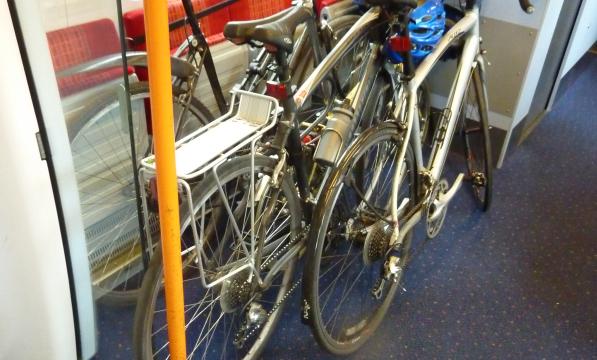Taking cycles on trains
By Cherry

Headline Message
- In the past few years, the amount of cycle parking available at many stations has increased in quality and quantity, and this is a welcome advance.
- However, as cycle use grows, more and more people will want to be able to take their cycles onboard with them, both for leisure and commuting trips.
Policy Key Facts
- In the UK, evidence suggests that the demand for cycle carriage on trains is around 4% of total seating capacity – a demand that is likely to grow as more and more people take up cycling. Theoretically, existing rolling stock is capable of meeting this demand while ideally, new (or newly refurbished trains) should be designed to provide for even more cycles.
- ‘Dedicated’ cycle spaces (i.e. space allocated specifically for cycles) are the best solution for cycle carriage, and some dedicated cycle space should be available on all trains.
- 'Flexible' space is less attractive (e.g. spaces that also provides tip-up seating) because it can be inconvenient and irritating for cycle users and other passengers alike. Nevertheless, it can provide a useful, additional cycle storage space.
- Being able to travel with tandems, tricycles and other cycles of non-standard dimensions makes an important contribution to the mobility of people with disabilities, especially for long(er) journeys. For some users, these machines are in fact mobility aids, helping them travel independently and more comfortably.
National Rail Enquiries supplies advice on taking your cycle with you on a train, plus information about each operator's cycle policy, i.e. restrictions, reservations etc. Look up the train company, then click on 'onboard facilities'.
Cycling UK View
We are currently revising and updating our views on cycle-rail and these will be published in due course. In the meantime, these are extracts from Cycling UK's current Policy Handbook (March 2004):
- Government should take a lead in implementing its commitments for cycle carriage by rail. They should further direct all related agencies to align their policies to facilitate cycle carriage on all rail services.
- Existing levels of cycle carriage provision should not be reduced or diminished when rolling stock is refurbished or replaced.
- Targets for minimum cycle carriage standards should be set at two levels:
- The 'first level' targets should specify what should be achieved in the short-term with existing rolling stock;
- The 'second level' targets should determine what should be provided when rolling stock is refurbished or new rolling stock commissioned.
- The “first level” should be to provide a minimum of four cycle spaces for the first 100 seats in any train formation, plus an additional cycle space for each complete or partial multiple of 30 seats thereafter.
- The “second level” target should be to provide a minimum of six cycle spaces for the first 100 seats in any train formation, plus an additional cycle space for each complete or partial multiple of 24 seats thereafter.
- At least 50% of the cycle spaces required to meet these targets should be 'dedicated' cycle provision, the remainder may be “dedicated” or “flexible” provision, but they should not be in locations where they obstruct passenger circulation.
- In accordance with disabled access requirements and the Government’s social inclusion objectives, it should be possible to carry at least one tandem or tricycle or trailer on any train, and at least one of the required cycle spaces per train formation should be designed to meet this requirement. Access to this storage should conform to the same dimensions as for electric wheelchairs, as virtually all cycles will fit within the same spatial envelope.
- Cycle spaces and securing arrangements should be designed and laid out so that they are easy and convenient to use.
- Cycle stowage areas on trains should be clearly labelled on both the outside and inside of the train. Information should also be available to cyclists advising them where to wait on the platform.
- Cycle carriage on trains should be free of charge and available without requirement to reserve in advance. There should be opportunities to reserve cycle spaces on all services where seat reservation systems are available, or on services whose train fleets do not meet the targets above; in such cases, the reservation should generally be free and certainly cost no more than a seat reservation for the same train.
- Cycling UK recognises that it may also be necessary to levy an appropriate reservation charge to limit demand on specific services where passenger demand regularly exceeds capacity. In such cases, cycle reservation charges should be aligned with cycle hire and/or parking charges at stations on the route served.
- Rail-substitute bus services and re-routed train services should permit the same number of cycles to be carried as the carrying capacity of the train service they replace.
- Rail routes in deep level tube tunnels should be made available for cycle carrying trains with trains and infrastructure embracing appropriate measures to satisfy special safety requirements, as these routes often provide unique opportunities to travel under natural barriers such as rivers.
2012-02-29 00:00:00 Europe/London

